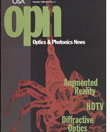
November 1998 Issue
Feature Articles
Diffractive Beauty
We often witness the beauty of nature, but fail to see the beauty of science and technology. A contest held this past summer in Hawaii demonstrates that the two are not mutually exclusive.
by Joseph N. MaitMounted Displays
Accurately rendering depth perception is one of the challenges of creating an augmented virtual world viewed through a head-mounted display. Rolland looks at this technology, discussing some of its applications and challenges.
by Jannick P. RollandHDTV: Re-inventing Television for the Digital Age
HDTV promises to change the way we experience television. This article looks at the advent and specifics of the technology, and the opportunities it presents to those in optics.
by Glenn A. ReitmeierStatus and Progress of Internet2
After the privatization of the Internet in 1995, new network applications for businesses, such as Web phones and electronic commerce, materialized. These developments, along with the increased popularity of the Internet, further strain the limited world network infrastructure. Additionally, invisible market forces drive profit margins that are so thin that Internet service providers (ISPs) have little incentive to upgrade.
by Chiu Tai LawPolarization Microscopy
The state of polarization of a given beam of light is modified upon reflection from (or transmission through) an object. The resulting change of the polarization state conveys information about the structure and certain physical properties of the illuminated region. Polarization microscopy is a variant of conventional optical microscopy that enables one to monitor these changes over a small area of a specimen. Such observations then allow the user to identify and analyze the specimen's structural and other physical features.
by Masud MansuripurAll-fused Silica 248-nm Lithographic Projection Lens
The objectives used in deep UV photolithography to image integrated circuit patterns onto silicon wafers are among the most sophisticated imaging systems ever developed. These systems are typically diffraction limited at an NA of 0.5 or more over a fairly large image area, with essentially zero distortion. In addition, there is normally a requirement that they be telecentric in both object and image spaces so that any small amount of defocus caused by curvature of the object or image planes will not result in the introduction of distortion. It is important to keep distortion to an absolute minimum because these objectives are used as part of a stepper system in which a wafer is exposed in numerous discrete steps. Any distortion in the objective will result in a slight mismatch of the tiny circuit features in adjacent exposures. Thus, it is necessary to keep the image displacement due to distortion below a small fraction of the smallest feature size.
by J. Brian CaldwellOptics at the Toy Store
The holiday season is nearly upon us, and many of us will be shopping for toys for the children, friends, and colleagues in our lives—not to mention for ourselves! So, what's available in the way of toys that make use of optics, exhibit interesting optical phenomena, or help teach kids about optics? For the benefit of loyal Light Touch readers, I conducted a little field research to answer these questions.
by Michael E. Knotts

![A multiplexed image of a human tonsil acquired. [NIAID] using the iterative bleaching extends multiplexity (IBEX) method.](https://opnmedia.blob.core.windows.net/$web/opn/media/images/articles/2024/0424/departments/202404-cover-web.jpg?ext=.jpg)
